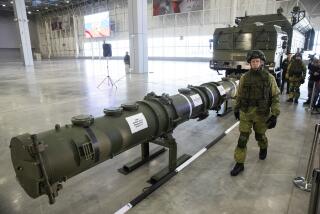Bush Is Caught in a Pentagon Time Warp : Defense: After the ‘revolution of 1989,’ it makes no sense to push for cuts in conventional arms while building up the nuclear arsenal.
- Share via
There is a time warp in Washington. In his State of the Union Address, President Bush correctly described the world in 1990: The diminishing Soviet military threat allows for greater and faster conventional-force reductions in Europe. Then he reverted to the language and logic of 1983: “We must sustain our own strategic offense modernization and the Strategic Defense Initiative.”
Today’s nuclear balance does not justify this policy conflict. While the Soviet Union and the United States each have different nuclear arsenals, both countries are grotesquely overarmed. There are 13,000 U.S. strategic weapons aimed at the Soviet Union; there are nearly 11,000 Soviet missiles aimed at us. In any nuclear exchange, the war would be over, with both nations destroyed, long before all existing weapons were detonated.
Why, then, does President Bush call for a continued nuclear-arms race? A look at the proposed 1991 budget provides the answer.
A listing of the new weapons systems under development or in production reveals that the Pentagon is still pursuing its strategic dream of nuclear superiority: five B-2 Stealth bombers; a Trident submarine (the 18th); 52 more Trident II missiles; 12 rail-mobile MX missiles; development of a new mobile Midgetman missile; a new aircraft-launched nuclear missile; 100 advanced air-launched cruise missiles and additional sea-launched cruise missiles; and a 23% increase in funding for the space-based missile defense program. Cost in 1991: $25 billion to $30 billion.
President Bush justifies this enormous expense by citing the Soviet Union’s continuing modernization of strategic forces. Actually, the Soviets are tailoring their nuclear forces to square with proposed limits in a future START agreement, as both Secretary of Defense Dick Cheney and CIA Director William H. Webster have testified. By contrast, the U.S. program is turning out nuclear arms in excess of these limits. New American tactical systems included in the budget would create additional layers of unneeded nuclear-fighting capabilities.
Moreover, an intensive research program involving an array of exotic “third generation” nuclear weapons is under way. X-ray and optical-frequency laser, hyper-velocity pellet and electro-magnetic-pulse weapons are being designed and developed. Maneuvering and earth-penetrating re-entry vehicles are also on the drawing boards. This research effort, unreported by the President, again signifies the Pentagon’s quest for the kind of technological superiority that has fueled the nuclear-arms race for 45 years.
These new offensive and defensive weapons will require extensive nuclear testing before they can become operational. That’s why the President has decided to defer further negotiations with the Soviet Union on test restrictions once current talks are completed. This will allow the United States to continue unlimited underground nuclear testing so long as the 150-kiloton limit is not exceeded.
There are political costs to this 1983 mind-set. The Administration’s refusal to consider test restrictions that would prevent development of exotic nuclear weaponry is a violation of U.S. commitments in two arms-control treaties. In the Limited Test Ban Treaty of 1963 and the Non-Proliferation Treaty of 1968, the United States pledged “to continue negotiations” leading to a cessation of nuclear testing.
Is sustaining the 45-year-old nuclear-arms race the appropriate response to “a singular moment in history” (to use the President’s words)? Beyond question, Mikhail Gorbachev and his country are on a far different course from that of even five years ago. To continue their new direction, they must lift the crushing economic burden of developing ever more nuclear weaponry. The Soviets temporarily halted nuclear testing in 1985 and are committed to stopping again when the United States does. They made major concessions to conclude an intermediate-range missile treaty in 1987; they are willing to do the same to get a START agreement.
Unless President Bush begins to think in nuclear terms about the changes created by “the revolution of 1989,” it appears that America will waste a priceless opportunity to reduce the dangers of nuclear war. It makes no sense to apply the logic of 1990 to conventional weapons while applying that of 1983 to nuclear weapons.
More to Read
Sign up for Essential California
The most important California stories and recommendations in your inbox every morning.
You may occasionally receive promotional content from the Los Angeles Times.









